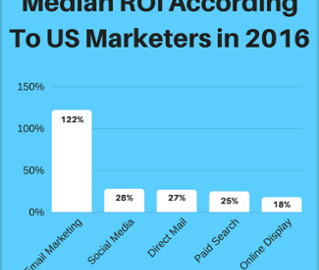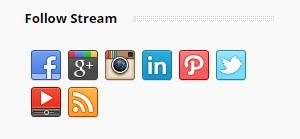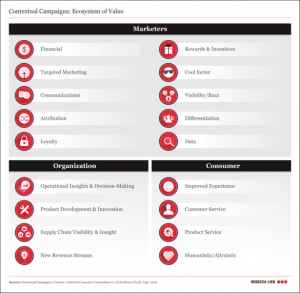There aren’t a lot of people saying this, but direct mail marketing is dead.
Actually…
Direct mail can still earn pretty remarkable returns, especially in certain industries.
But, the ROI that direct mail offers has slowly decreased over time while ROI for email marketing continues to grow.In fact, a recent eMarketer survey uncovered a median ROI of 122% for US marketers using email marketing. Compare that to 28% ROI for social media advertising, 27% for direct mail and 25% for paid search ads.

The 122% ROI listed isn’t the only email marketing ROI case study that’s been documented. Here are some more case studies that are available online:
ROI case studies for email marketing
- 80% – According to agency professionals surveyed by eConsultancy
- 73% – According to in-house marketers surveyed by eConsultancy
- 3,800% – According to DMA (presented by emailmonday)
- 28.5% (in 2012) – According to Chief Marketer
- 2,600% – According to a study by Hubspot
As you can see, the ROI for these examples varies widely, from 73% to a whopping 3,800 percent. The point of showing these figures is to say that each company, each industry, each quarter…each application of email marketing is going to provide different results.
How much are companies spending to get these results?
Again, each case is going to be a little different. Let’s take a look at a few of the case studies from above:
For the marketers that eConsultancy surveyed – who reported returns of 73-80% – an average of 16% of the total marketing budget was spent on email marketing. Not only did the results achieve up to 80% ROI, they also accounted for an incredible 23% of the marketers’ total sales for 2016.
In the Hubspot case study, it only took a small investment in email to achieve results similar to the much more costly efforts of direct mail. This was an interesting study because it didn’t just examine the difference between email and direct mail. It also examined the efficacy of direct mail and email together.
For the direct mail campaign, they spent $ 21,000 and generated revenue of $ 576,408. When combining direct mail with email, ROI improved slightly: They spend $ 21,210 and made $ 627,463. For the email only campaign, they generated slightly less revenue at $ 545,951 but spent only a small fraction of the investment at $ 210 total.
That’s where the 2600% ROI comes from and it can be compared to 27% ROI for their direct mail only efforts and 30% ROI for their direct mail + email campaign.
What do these case studies mean – should you spend just a couple hundred dollars on your email marketing and expect over $ 500,000 in revenue?
No…these results are not typical, though they are possible.
The 16% of total marketing budget is closer to the amount you should consider investing specifically in your email marketing efforts. But that figure will vary depending on several factors, including the following factors:
- Your annual revenue
- Whether your company is B2B or B2C
- Whether you’re selling a product or a service
- How much of your overall revenue is generated online
- Your marketing and digital marketing goals
Here’s a quick way to calculate your email marketing budget and more…
How to achieve great ROI from email marketing
There is clearly a lot of opportunity with email marketing efforts. The question now becomes how to go about achieving that ROI…
Of course, it’s important to note that every business is different and there is no secret combination of contacts and emails that will automatically take you to the top.
But, there are some best practices that you should consider when putting together your email marketing campaign.
Here are 3 of the most important ones:
1. Choose the best email marketing platform for your business
Just like every email marketing approach is different based on many factors, the right email marketing platform will be different for each company as well.
Your email marketing platform could be part of a larger marketing automation and CRM platform, such as Hubspot or Infusionsoft, or it might be a more simple email platform, such as MailChimp. No matter what you’re using now, you need to consider what your email marketing demands are now and what you want them to be in the future.
Also consider how quickly you plan to grow your email marketing efforts; if you expect to grow from 300 contacts to 10,000 contacts in the next few months then you should go ahead and get setup with a more robust email marketing platform.
Not only will that allow you to avoid a potentially tedious transition down the road, it will also provide the opportunity to get familiar with the email platform while you grow your database.
Here are some of the most common email marketing platforms for different budgets and stages of business growth:
Email marketing platforms for businesses that have a small database now and don’t plan on growing quickly or have a tight budget:
- MailChimp (Free to $ 199/mo)
- Constant Contact (starting at $ 20/mo)
- GetResponse ($ 15/mo to $ 999/mo)
Email marketing platforms for businesses that want room to grow and have a decent email marketing budget:
- Hubspot (now starting with a basic free option)
- ActiveCampaign (starting at $ 9/mo)
- Infusionsoft (starting at $ 199/mo)
- Salesforce Pardot (starting at $ 1,000/mo)
Most businesses can find a fitting email marketing platform in the options listed above. But the two platforms that really stand out are Hubspot and ActiveCampaign.
There has been a lot of disruption in the email marketing platform market over the past couple years and these two have done a great job at carving out places in that market.
Hubspot is a well-known platform that is robust and allows for email scheduling, contact engagement tracking, email workflow automation and much more. Until 2017, Hubspot would be quickly dismissed by smaller companies because of the pricing. But in 2017, they introduced an introductory plan that Free, allowing businesses to start off with Hubspot and grow into the more robust plans.
ActiveCampaign is one of the market disrupters and was one of the first platforms to offer a larger range of services – from email workflow automation to easy-to-use email templates to forms and more – all offered at a starting price of $ 9/month.
Depending on your email marketing budget and goals, either of these two can be great options to get you started and build your email marketing efforts over time.
If you plan on getting serious about email then the platform you choose will likely be your largest email marketing expenditure, aside from perhaps employee pay.
2. You must make sure your sales team is ready to handle a higher volume of leads
This is a critical step in achieving the maximum ROI from your email marketing efforts. You could have a million dollar email marketing budget but if your sales team can’t support the traffic then you’ll never be able to take full advantage of the leads your email marketing efforts can provide.
Keep in mind: A busy sales team does not necessarily mean a productive one. If you boost your marketing efforts, you might notice an increase in leads and prospects – and maybe even paying customers – but don’t confuse a busier sales team that isn’t closing more deals with one that is efficiently working through the increased demand.
Your goal should be to create a scalable sales process that will allow you to take advantage of increased leads when they come but not put too much of a strain on your resources (eg employee compensation).
Each business will go about this is in a unique way. If your leads all come through via phone calls, even when prompted by emails, then you might consider a phone answering service or updating phone answering protocol for sales members.
If most of your leads are coming through forms online then you can consider workflow automation, form notifications to the sales team and so on.
You may need to invest more into your sales process, so consider that as you carve out your email marketing (and total marketing) budget. For some, no extra budget will be needed – it may just be a matter of thinking differently or shuffling resources. For others, you may only spend a little extra on additional features of an email marketing platform (such as email workflow automation) or you may spend a great deal restructuring your sales process.
3. Make sure you’re connecting with the (right) audience
The last thing you want to do with your email marketing is allocate part of your budget towards a new email marketing platform and restructure your sales process only to later realize that you’re really not connecting with the right audience in your email messages.
Connecting with the right audience has three different parts:
1. Knowing what your target market is and will be
If you currently have a business then you have some sort of an existing audience, even if it’s just 5 people in your hometown. But there may be a difference between who your existing buyers are and who the right buyers for your company are.
Here’s an example: You own a business that sells high-quality winter jackets. You’re based in Virginia and you’ve done well enough to take your business online. You start off selling your jackets across the state of Virginia because of the proximity.
The problem is that Virginia has many months of warm to hot weather. By only targeting people in Virginia, you’ll see whole months out of the year when nobody will be interested in your jackets (just like your physical location). The remedy would be to expand into territories that experience longer periods of colder weather.
By including markets like New York and New England, the amount of time that people need to buy jackets will likely increase. So, while your current audience may be a city in Virginia, it’s important to consider what your audience will look like as you grow your business.
2. Understanding the people in your target market
Knowing where your audience is and knowing who your audience is are completely different subjects. The more that you understand your customers, the more you will understand the reasons they shop, the reasons they buy and even the reasons they do not buy.
If you’ve been in business for a long time then you’re thinking you know your customers thoroughly. But, you’d be surprised how much documenting customers’ attributes can help provide an even deeper understanding. This is especially true for businesses who have multiple types of buyers, or personas.
The reason why this is so important is that it can dictate how you market and sell to your audiences.
For instance, let’s say you decide you’ll expand your winter jacket business to New England while maintaining your local business in Virginia. Your buyers in Virginia will be a lot different than your buyers in New England, right?
They’ll be buying for different reasons, they’ll have different expectations of product quality, they’ll use the products differently, they’ll shop around differently and they’ll even talk differently.
Understanding how each audience thinks, talks, buys, etc. will you give you an incredible upper-hand when it’s time to implement your email marketing campaign.
3. Investing in creative resources to communicate effectively
Now that you understand what your target markets are and also who they are, it’s important to invest in the best resources to connect with those people. Simply understanding those things and then trying to communicate the same way you always have will certainly decrease the chances of connecting with them in your email messaging.
Instead, you should designate one of your team members (ideally, someone creative) to craft new messaging that will resonate with your audience members. When you start this process, you may be surprised to notice that you’re not even talking to your existing audience in the most effective way.
The key goal here is to avoid speaking in your own language (industry lingo is one of the top offenders) and start speaking the way your audience does. Now, it’s important to maintain the “voice” of your brand if you’ve established one, but you want to at least find a middle ground.
Example: Let’s say your winter jacket company is booming and is now hands-off. You decided to go back to school and become a veterinarian–your dream job. Your clinic is up and running and you’re emailing existing customers about a new product that was released to prevent Lyme Disease. You should not refer to Lyme Disease by its medical name, Borreliosis. Sure, it may make you sound smarter and some people may understand it, but the majority will not.
Even if your Lyme Disease product is the best in the world, it won’t matter because you’re speaking a language that your audience does not speak.
It can be very easy to discover how your audience talks. Here are some ways that you or your creative team gain a better understanding of how your audience talks:
- Send out surveys. Surveys are a great way to get more in touch with your customers. Not only can you ask questions about their satisfaction with your products, you can examine the language they use in their responses. Now you’ll see that customers are concerned about Lyme Disease even though you just sent your Borreliosis email out and you can make that change for the next email.
- Record or make notes during phone calls. For businesses that get a lot of phone calls from customers, this is a great way to examine exactly what customers are calling for and the terminology they use when they call.
- Check social media. If you have a decent following on social media and your audience is engaged with your pages, take a look through their comments and make notes on how they’re writing to you. Even better, try publishing posts around the topic you’ll be emailing them about and you’ll have more luck getting specific language around those topics.
- Search for online blogs and forums. You may be surprised at how easy it is to find people like your customers online using blogs and forums to interact. These sites are perfect for understanding how your customers think and speak about their problems.
The effort that you put into communicate effectively may also become part of your email marketing budget, but this is one that you will likely find to be very valuable.
Putting it all together to achieve optimal ROI from email marketing
Unfortunately, there is no magic budget amount that will automatically earn you an incredible ROI from email marketing. Every business is different and that means that each company’s email marketing efforts should look a little different too.
With that said, there are some standards for getting the most out of your email marketing budget and efforts. Most importantly, you need to establish your marketing and business goals that you know what you are aiming for with your investment.
It’s also critical to choose the right email marketing platform to support those goals and ensuring that your sales process is set up to take advantage of the increased interest when it begins. Lastly, you need to make sure you know your target audience and how to communicate with them effectively.
Without those three components, you won’t be able to reach the full potential of your email marketing efforts and you may become discouraged by poor ROI.
Reminder: You can use the digital marketing budget calculator below for marketing budget recommendations that are customized for your business:
Digital & Social Articles on Business 2 Community
(117)






